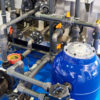Over the past 10-15 years, cartridge filters have become much more common in SW Florida. Most agree that the operating cost of a cartridge filter is much less than a Diatomaceous earth or even a sand filter, since it eliminates wasted water (from backwashing) and chemical costs (from having to re-charge). It also has become the better alternative from an environmental standpoint for these reasons.
One of the most common oversights in maintaining a swimming pool with a cartridge filter is failure to replace the cartridge or element when it is necessary to do so. Most manufacturers will tell you to replace it after 10-12 cleaning cycles. Normally, the cleaning cycle will vary anywhere from one month to 2 months, depending on the bather load of the pool and what has been found to be necessary by the user, given other environmental factors. To put it simply, the more dirt and body oils you run through your filter, the more often it needs to be cleaned AND changed out.
As a rule, we normally track the lifespan of each of our customers’ filter cartridge, and after roughly two years, we automatically replace them. In other cases, we replace it sooner; when wear and tear has made even more frequent replacement necessary.
But how do you know?
- Know your filter’s “starting pressure.” This is the minimum pressure you will be able to achieve on your filter pressure gauge. This can vary considerably from pool to pool, because it is affected by so many variables, for example: pump horsepower, plumbing size and layout, etc. Make a note of the PSI right after you have placed a new cartridge in the filter. Or another way of determining your starting pressure is to take the cartridge out of the filter and see what the PSI reads with nothing inside. If you are still getting more than 5 PSI above your starting pressure, even after you have cleaned the cartridge, you need to replace it.
- Automatically replacing the filter after the given period of time (suggested above) assures that the material inside, which degrades over time, will be in adequate shape to filter the water. Your filter might be missing a good deal of particles that it otherwise would remove from the water if it was new.




